Nursing Case Study on Acute Asthma: Pathogenesis and Management
VerifiedAdded on 2023/06/03
|9
|2178
|99
AI Summary
This nursing case study discusses the pathogenesis and management of acute asthma. It covers the clinical manifestations, pharmacological treatment, and nursing strategies for patients with acute asthma.
Contribute Materials
Your contribution can guide someone’s learning journey. Share your
documents today.
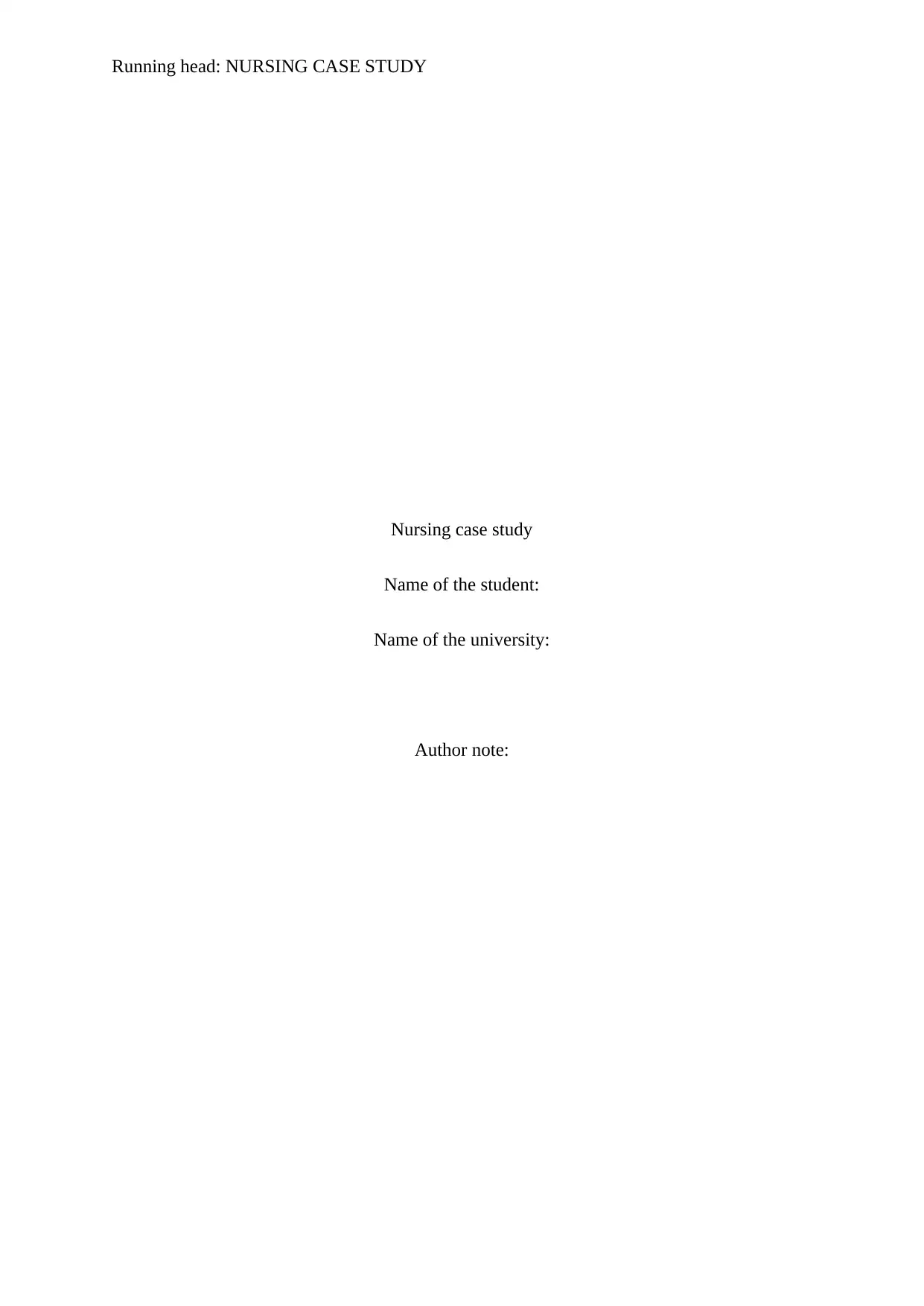
Running head: NURSING CASE STUDY
Nursing case study
Name of the student:
Name of the university:
Author note:
Nursing case study
Name of the student:
Name of the university:
Author note:
Secure Best Marks with AI Grader
Need help grading? Try our AI Grader for instant feedback on your assignments.
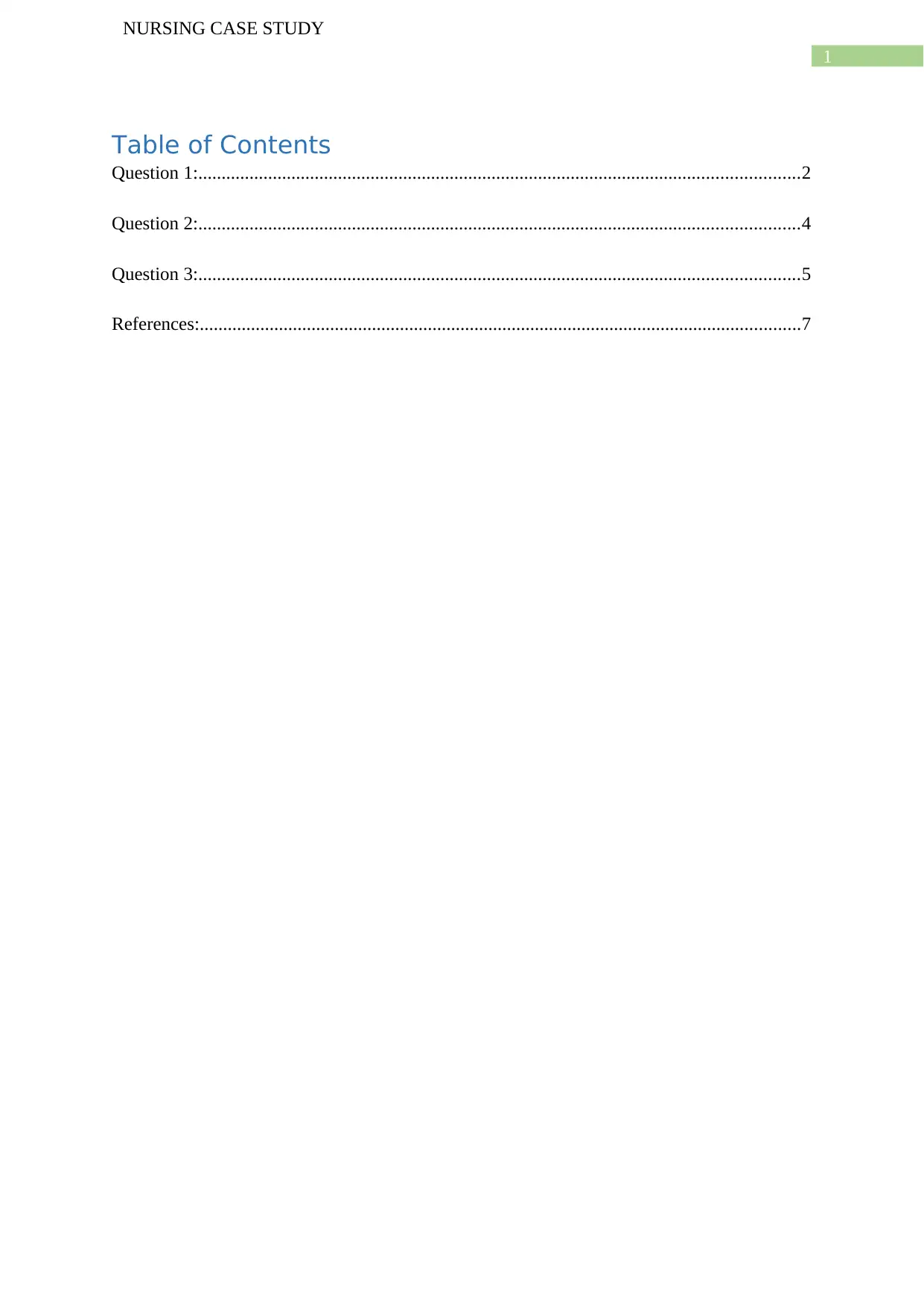
1
NURSING CASE STUDY
Table of Contents
Question 1:.................................................................................................................................2
Question 2:.................................................................................................................................4
Question 3:.................................................................................................................................5
References:.................................................................................................................................7
NURSING CASE STUDY
Table of Contents
Question 1:.................................................................................................................................2
Question 2:.................................................................................................................................4
Question 3:.................................................................................................................................5
References:.................................................................................................................................7
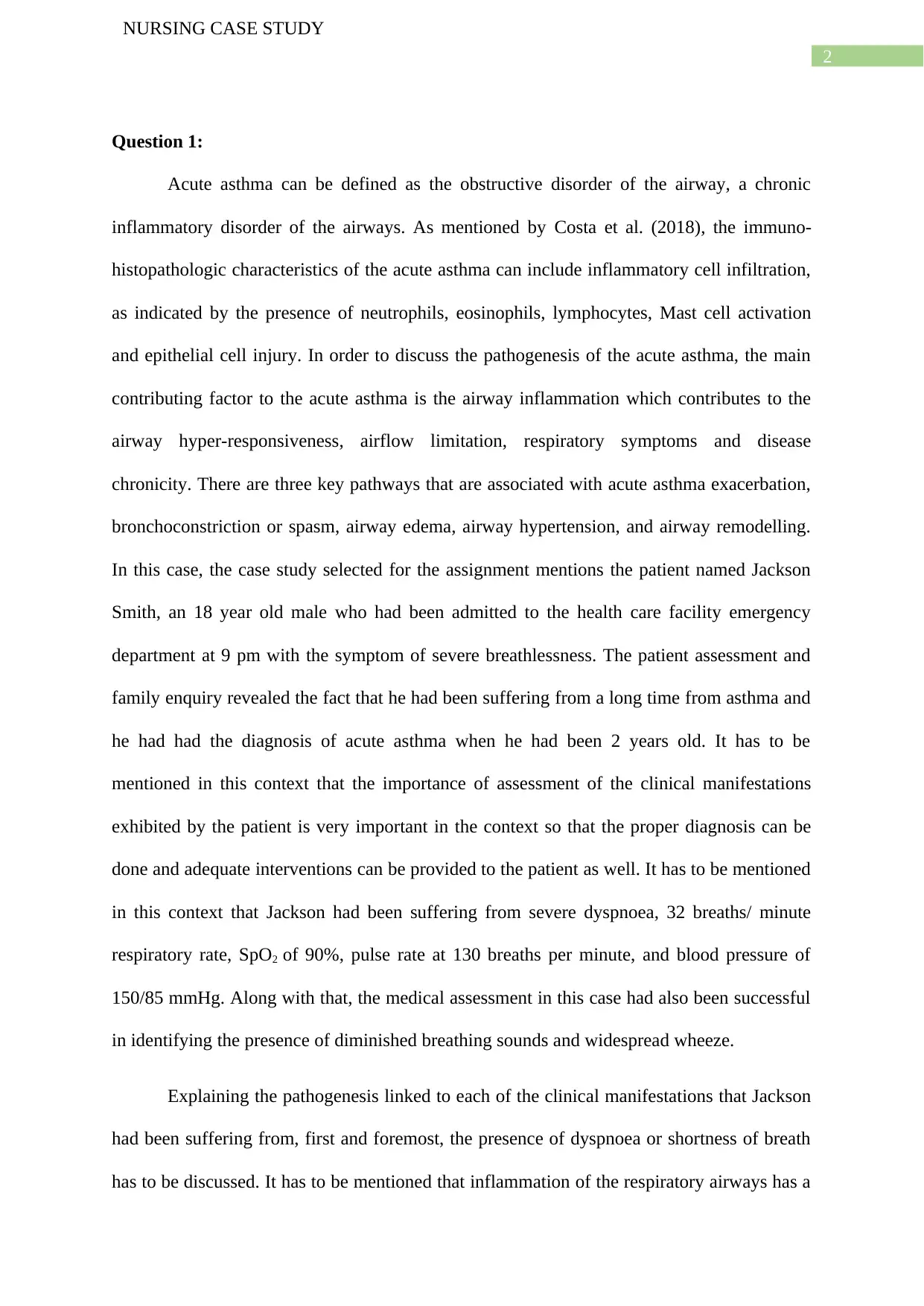
2
NURSING CASE STUDY
Question 1:
Acute asthma can be defined as the obstructive disorder of the airway, a chronic
inflammatory disorder of the airways. As mentioned by Costa et al. (2018), the immuno-
histopathologic characteristics of the acute asthma can include inflammatory cell infiltration,
as indicated by the presence of neutrophils, eosinophils, lymphocytes, Mast cell activation
and epithelial cell injury. In order to discuss the pathogenesis of the acute asthma, the main
contributing factor to the acute asthma is the airway inflammation which contributes to the
airway hyper-responsiveness, airflow limitation, respiratory symptoms and disease
chronicity. There are three key pathways that are associated with acute asthma exacerbation,
bronchoconstriction or spasm, airway edema, airway hypertension, and airway remodelling.
In this case, the case study selected for the assignment mentions the patient named Jackson
Smith, an 18 year old male who had been admitted to the health care facility emergency
department at 9 pm with the symptom of severe breathlessness. The patient assessment and
family enquiry revealed the fact that he had been suffering from a long time from asthma and
he had had the diagnosis of acute asthma when he had been 2 years old. It has to be
mentioned in this context that the importance of assessment of the clinical manifestations
exhibited by the patient is very important in the context so that the proper diagnosis can be
done and adequate interventions can be provided to the patient as well. It has to be mentioned
in this context that Jackson had been suffering from severe dyspnoea, 32 breaths/ minute
respiratory rate, SpO2 of 90%, pulse rate at 130 breaths per minute, and blood pressure of
150/85 mmHg. Along with that, the medical assessment in this case had also been successful
in identifying the presence of diminished breathing sounds and widespread wheeze.
Explaining the pathogenesis linked to each of the clinical manifestations that Jackson
had been suffering from, first and foremost, the presence of dyspnoea or shortness of breath
has to be discussed. It has to be mentioned that inflammation of the respiratory airways has a
NURSING CASE STUDY
Question 1:
Acute asthma can be defined as the obstructive disorder of the airway, a chronic
inflammatory disorder of the airways. As mentioned by Costa et al. (2018), the immuno-
histopathologic characteristics of the acute asthma can include inflammatory cell infiltration,
as indicated by the presence of neutrophils, eosinophils, lymphocytes, Mast cell activation
and epithelial cell injury. In order to discuss the pathogenesis of the acute asthma, the main
contributing factor to the acute asthma is the airway inflammation which contributes to the
airway hyper-responsiveness, airflow limitation, respiratory symptoms and disease
chronicity. There are three key pathways that are associated with acute asthma exacerbation,
bronchoconstriction or spasm, airway edema, airway hypertension, and airway remodelling.
In this case, the case study selected for the assignment mentions the patient named Jackson
Smith, an 18 year old male who had been admitted to the health care facility emergency
department at 9 pm with the symptom of severe breathlessness. The patient assessment and
family enquiry revealed the fact that he had been suffering from a long time from asthma and
he had had the diagnosis of acute asthma when he had been 2 years old. It has to be
mentioned in this context that the importance of assessment of the clinical manifestations
exhibited by the patient is very important in the context so that the proper diagnosis can be
done and adequate interventions can be provided to the patient as well. It has to be mentioned
in this context that Jackson had been suffering from severe dyspnoea, 32 breaths/ minute
respiratory rate, SpO2 of 90%, pulse rate at 130 breaths per minute, and blood pressure of
150/85 mmHg. Along with that, the medical assessment in this case had also been successful
in identifying the presence of diminished breathing sounds and widespread wheeze.
Explaining the pathogenesis linked to each of the clinical manifestations that Jackson
had been suffering from, first and foremost, the presence of dyspnoea or shortness of breath
has to be discussed. It has to be mentioned that inflammation of the respiratory airways has a
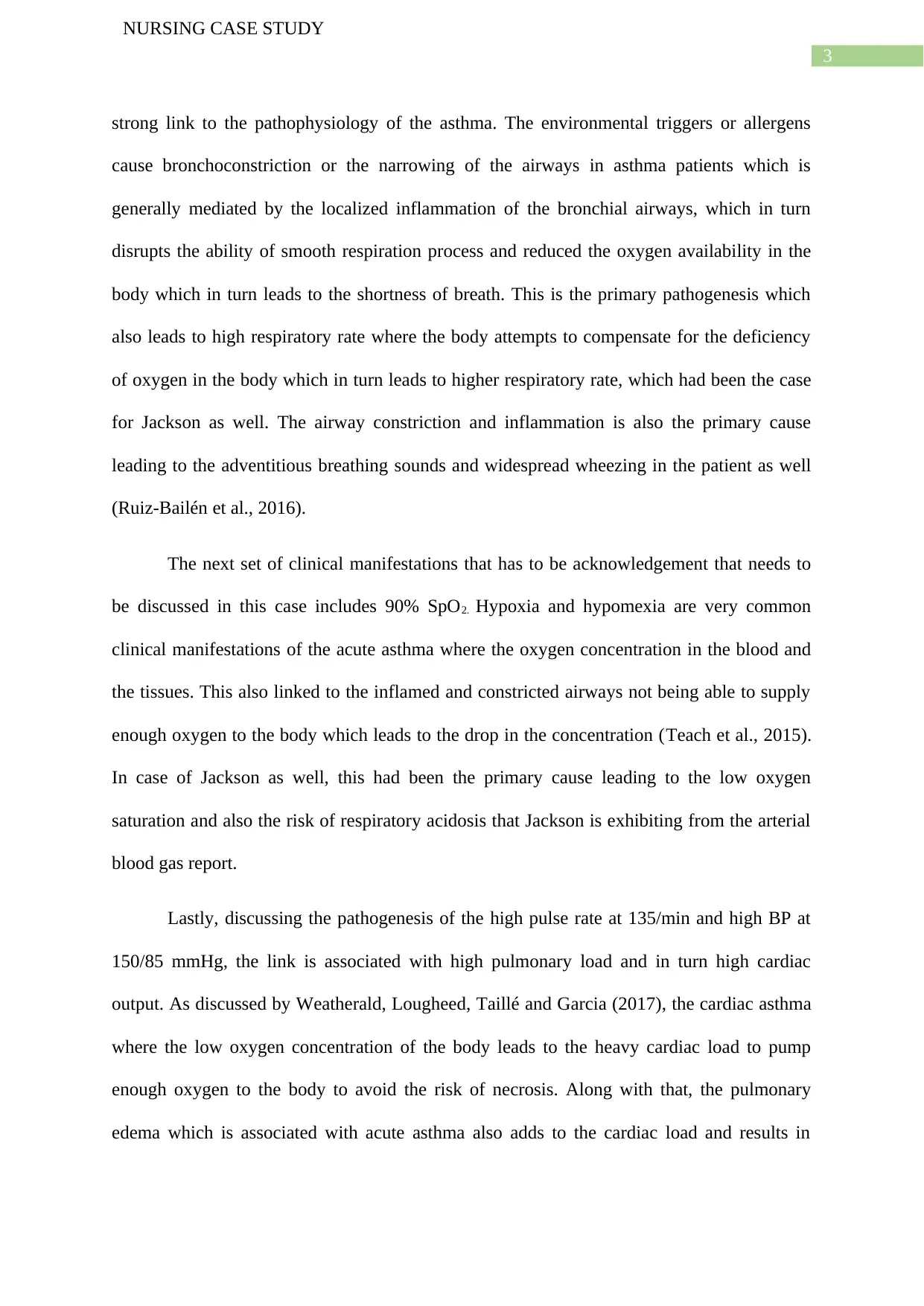
3
NURSING CASE STUDY
strong link to the pathophysiology of the asthma. The environmental triggers or allergens
cause bronchoconstriction or the narrowing of the airways in asthma patients which is
generally mediated by the localized inflammation of the bronchial airways, which in turn
disrupts the ability of smooth respiration process and reduced the oxygen availability in the
body which in turn leads to the shortness of breath. This is the primary pathogenesis which
also leads to high respiratory rate where the body attempts to compensate for the deficiency
of oxygen in the body which in turn leads to higher respiratory rate, which had been the case
for Jackson as well. The airway constriction and inflammation is also the primary cause
leading to the adventitious breathing sounds and widespread wheezing in the patient as well
(Ruiz-Bailén et al., 2016).
The next set of clinical manifestations that has to be acknowledgement that needs to
be discussed in this case includes 90% SpO2. Hypoxia and hypomexia are very common
clinical manifestations of the acute asthma where the oxygen concentration in the blood and
the tissues. This also linked to the inflamed and constricted airways not being able to supply
enough oxygen to the body which leads to the drop in the concentration (Teach et al., 2015).
In case of Jackson as well, this had been the primary cause leading to the low oxygen
saturation and also the risk of respiratory acidosis that Jackson is exhibiting from the arterial
blood gas report.
Lastly, discussing the pathogenesis of the high pulse rate at 135/min and high BP at
150/85 mmHg, the link is associated with high pulmonary load and in turn high cardiac
output. As discussed by Weatherald, Lougheed, Taillé and Garcia (2017), the cardiac asthma
where the low oxygen concentration of the body leads to the heavy cardiac load to pump
enough oxygen to the body to avoid the risk of necrosis. Along with that, the pulmonary
edema which is associated with acute asthma also adds to the cardiac load and results in
NURSING CASE STUDY
strong link to the pathophysiology of the asthma. The environmental triggers or allergens
cause bronchoconstriction or the narrowing of the airways in asthma patients which is
generally mediated by the localized inflammation of the bronchial airways, which in turn
disrupts the ability of smooth respiration process and reduced the oxygen availability in the
body which in turn leads to the shortness of breath. This is the primary pathogenesis which
also leads to high respiratory rate where the body attempts to compensate for the deficiency
of oxygen in the body which in turn leads to higher respiratory rate, which had been the case
for Jackson as well. The airway constriction and inflammation is also the primary cause
leading to the adventitious breathing sounds and widespread wheezing in the patient as well
(Ruiz-Bailén et al., 2016).
The next set of clinical manifestations that has to be acknowledgement that needs to
be discussed in this case includes 90% SpO2. Hypoxia and hypomexia are very common
clinical manifestations of the acute asthma where the oxygen concentration in the blood and
the tissues. This also linked to the inflamed and constricted airways not being able to supply
enough oxygen to the body which leads to the drop in the concentration (Teach et al., 2015).
In case of Jackson as well, this had been the primary cause leading to the low oxygen
saturation and also the risk of respiratory acidosis that Jackson is exhibiting from the arterial
blood gas report.
Lastly, discussing the pathogenesis of the high pulse rate at 135/min and high BP at
150/85 mmHg, the link is associated with high pulmonary load and in turn high cardiac
output. As discussed by Weatherald, Lougheed, Taillé and Garcia (2017), the cardiac asthma
where the low oxygen concentration of the body leads to the heavy cardiac load to pump
enough oxygen to the body to avoid the risk of necrosis. Along with that, the pulmonary
edema which is associated with acute asthma also adds to the cardiac load and results in
Secure Best Marks with AI Grader
Need help grading? Try our AI Grader for instant feedback on your assignments.
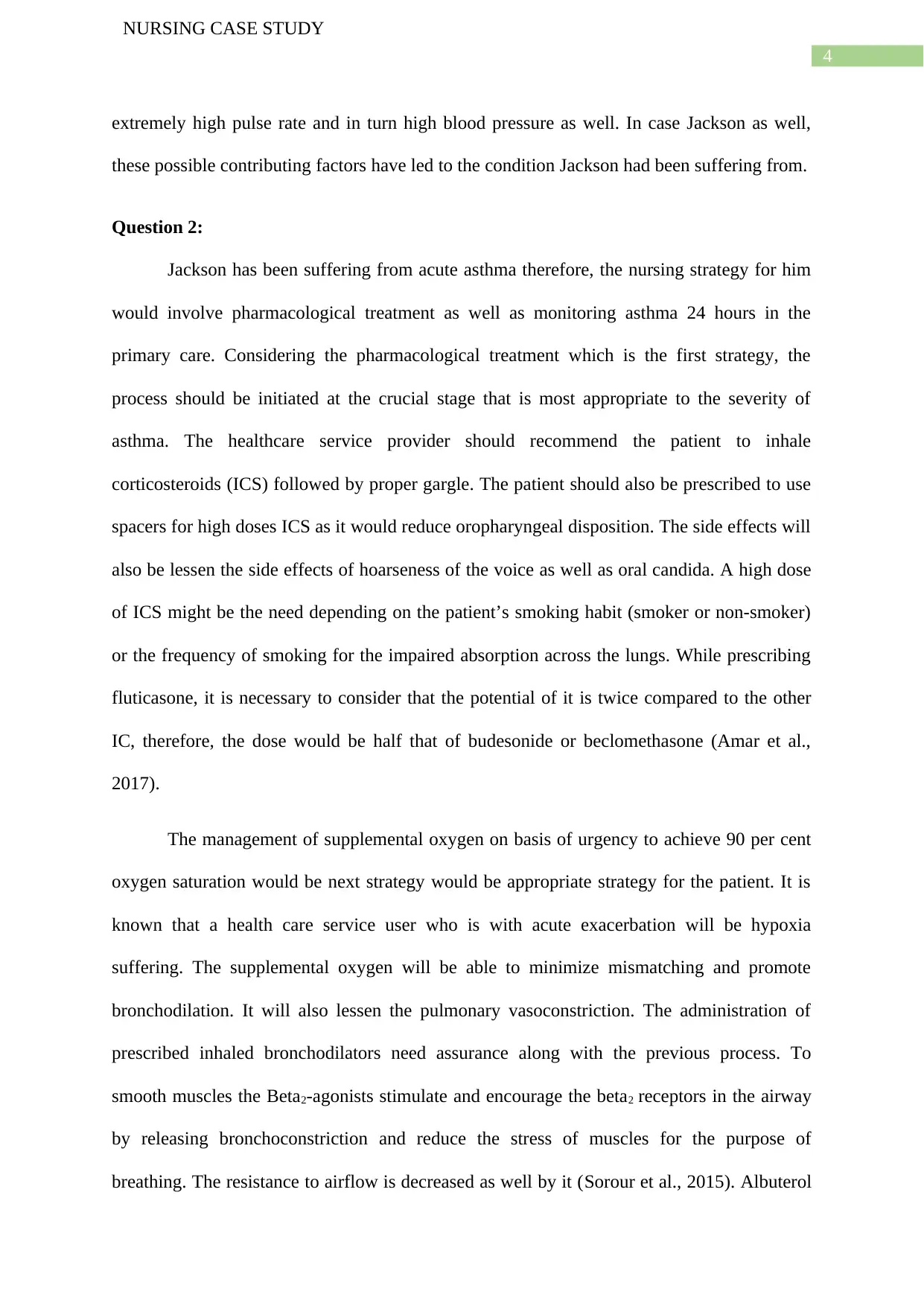
4
NURSING CASE STUDY
extremely high pulse rate and in turn high blood pressure as well. In case Jackson as well,
these possible contributing factors have led to the condition Jackson had been suffering from.
Question 2:
Jackson has been suffering from acute asthma therefore, the nursing strategy for him
would involve pharmacological treatment as well as monitoring asthma 24 hours in the
primary care. Considering the pharmacological treatment which is the first strategy, the
process should be initiated at the crucial stage that is most appropriate to the severity of
asthma. The healthcare service provider should recommend the patient to inhale
corticosteroids (ICS) followed by proper gargle. The patient should also be prescribed to use
spacers for high doses ICS as it would reduce oropharyngeal disposition. The side effects will
also be lessen the side effects of hoarseness of the voice as well as oral candida. A high dose
of ICS might be the need depending on the patient’s smoking habit (smoker or non-smoker)
or the frequency of smoking for the impaired absorption across the lungs. While prescribing
fluticasone, it is necessary to consider that the potential of it is twice compared to the other
IC, therefore, the dose would be half that of budesonide or beclomethasone (Amar et al.,
2017).
The management of supplemental oxygen on basis of urgency to achieve 90 per cent
oxygen saturation would be next strategy would be appropriate strategy for the patient. It is
known that a health care service user who is with acute exacerbation will be hypoxia
suffering. The supplemental oxygen will be able to minimize mismatching and promote
bronchodilation. It will also lessen the pulmonary vasoconstriction. The administration of
prescribed inhaled bronchodilators need assurance along with the previous process. To
smooth muscles the Beta2-agonists stimulate and encourage the beta2 receptors in the airway
by releasing bronchoconstriction and reduce the stress of muscles for the purpose of
breathing. The resistance to airflow is decreased as well by it (Sorour et al., 2015). Albuterol
NURSING CASE STUDY
extremely high pulse rate and in turn high blood pressure as well. In case Jackson as well,
these possible contributing factors have led to the condition Jackson had been suffering from.
Question 2:
Jackson has been suffering from acute asthma therefore, the nursing strategy for him
would involve pharmacological treatment as well as monitoring asthma 24 hours in the
primary care. Considering the pharmacological treatment which is the first strategy, the
process should be initiated at the crucial stage that is most appropriate to the severity of
asthma. The healthcare service provider should recommend the patient to inhale
corticosteroids (ICS) followed by proper gargle. The patient should also be prescribed to use
spacers for high doses ICS as it would reduce oropharyngeal disposition. The side effects will
also be lessen the side effects of hoarseness of the voice as well as oral candida. A high dose
of ICS might be the need depending on the patient’s smoking habit (smoker or non-smoker)
or the frequency of smoking for the impaired absorption across the lungs. While prescribing
fluticasone, it is necessary to consider that the potential of it is twice compared to the other
IC, therefore, the dose would be half that of budesonide or beclomethasone (Amar et al.,
2017).
The management of supplemental oxygen on basis of urgency to achieve 90 per cent
oxygen saturation would be next strategy would be appropriate strategy for the patient. It is
known that a health care service user who is with acute exacerbation will be hypoxia
suffering. The supplemental oxygen will be able to minimize mismatching and promote
bronchodilation. It will also lessen the pulmonary vasoconstriction. The administration of
prescribed inhaled bronchodilators need assurance along with the previous process. To
smooth muscles the Beta2-agonists stimulate and encourage the beta2 receptors in the airway
by releasing bronchoconstriction and reduce the stress of muscles for the purpose of
breathing. The resistance to airflow is decreased as well by it (Sorour et al., 2015). Albuterol
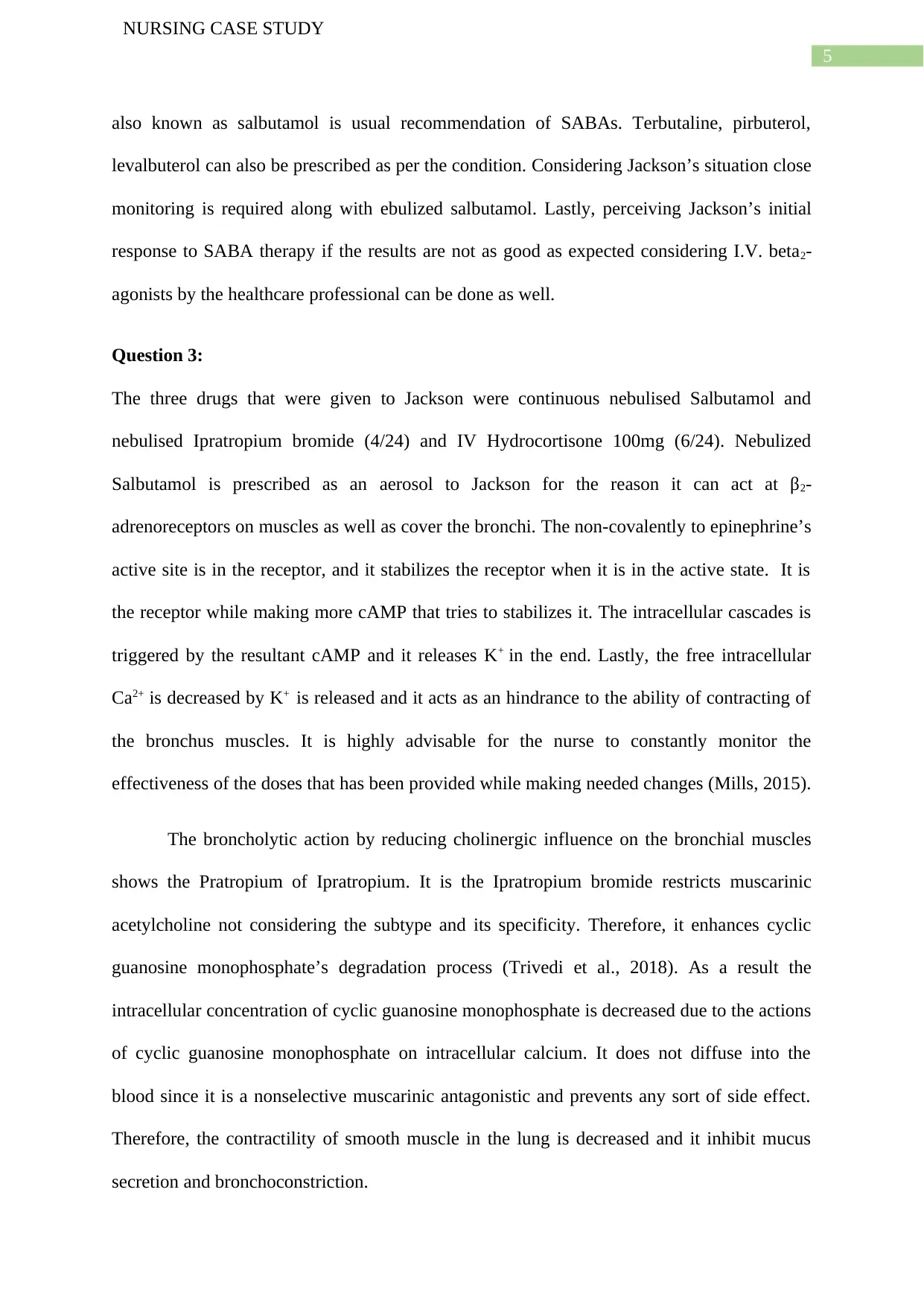
5
NURSING CASE STUDY
also known as salbutamol is usual recommendation of SABAs. Terbutaline, pirbuterol,
levalbuterol can also be prescribed as per the condition. Considering Jackson’s situation close
monitoring is required along with ebulized salbutamol. Lastly, perceiving Jackson’s initial
response to SABA therapy if the results are not as good as expected considering I.V. beta2-
agonists by the healthcare professional can be done as well.
Question 3:
The three drugs that were given to Jackson were continuous nebulised Salbutamol and
nebulised Ipratropium bromide (4/24) and IV Hydrocortisone 100mg (6/24). Nebulized
Salbutamol is prescribed as an aerosol to Jackson for the reason it can act at β2-
adrenoreceptors on muscles as well as cover the bronchi. The non-covalently to epinephrine’s
active site is in the receptor, and it stabilizes the receptor when it is in the active state. It is
the receptor while making more cAMP that tries to stabilizes it. The intracellular cascades is
triggered by the resultant cAMP and it releases K+ in the end. Lastly, the free intracellular
Ca2+ is decreased by K+ is released and it acts as an hindrance to the ability of contracting of
the bronchus muscles. It is highly advisable for the nurse to constantly monitor the
effectiveness of the doses that has been provided while making needed changes (Mills, 2015).
The broncholytic action by reducing cholinergic influence on the bronchial muscles
shows the Pratropium of Ipratropium. It is the Ipratropium bromide restricts muscarinic
acetylcholine not considering the subtype and its specificity. Therefore, it enhances cyclic
guanosine monophosphate’s degradation process (Trivedi et al., 2018). As a result the
intracellular concentration of cyclic guanosine monophosphate is decreased due to the actions
of cyclic guanosine monophosphate on intracellular calcium. It does not diffuse into the
blood since it is a nonselective muscarinic antagonistic and prevents any sort of side effect.
Therefore, the contractility of smooth muscle in the lung is decreased and it inhibit mucus
secretion and bronchoconstriction.
NURSING CASE STUDY
also known as salbutamol is usual recommendation of SABAs. Terbutaline, pirbuterol,
levalbuterol can also be prescribed as per the condition. Considering Jackson’s situation close
monitoring is required along with ebulized salbutamol. Lastly, perceiving Jackson’s initial
response to SABA therapy if the results are not as good as expected considering I.V. beta2-
agonists by the healthcare professional can be done as well.
Question 3:
The three drugs that were given to Jackson were continuous nebulised Salbutamol and
nebulised Ipratropium bromide (4/24) and IV Hydrocortisone 100mg (6/24). Nebulized
Salbutamol is prescribed as an aerosol to Jackson for the reason it can act at β2-
adrenoreceptors on muscles as well as cover the bronchi. The non-covalently to epinephrine’s
active site is in the receptor, and it stabilizes the receptor when it is in the active state. It is
the receptor while making more cAMP that tries to stabilizes it. The intracellular cascades is
triggered by the resultant cAMP and it releases K+ in the end. Lastly, the free intracellular
Ca2+ is decreased by K+ is released and it acts as an hindrance to the ability of contracting of
the bronchus muscles. It is highly advisable for the nurse to constantly monitor the
effectiveness of the doses that has been provided while making needed changes (Mills, 2015).
The broncholytic action by reducing cholinergic influence on the bronchial muscles
shows the Pratropium of Ipratropium. It is the Ipratropium bromide restricts muscarinic
acetylcholine not considering the subtype and its specificity. Therefore, it enhances cyclic
guanosine monophosphate’s degradation process (Trivedi et al., 2018). As a result the
intracellular concentration of cyclic guanosine monophosphate is decreased due to the actions
of cyclic guanosine monophosphate on intracellular calcium. It does not diffuse into the
blood since it is a nonselective muscarinic antagonistic and prevents any sort of side effect.
Therefore, the contractility of smooth muscle in the lung is decreased and it inhibit mucus
secretion and bronchoconstriction.
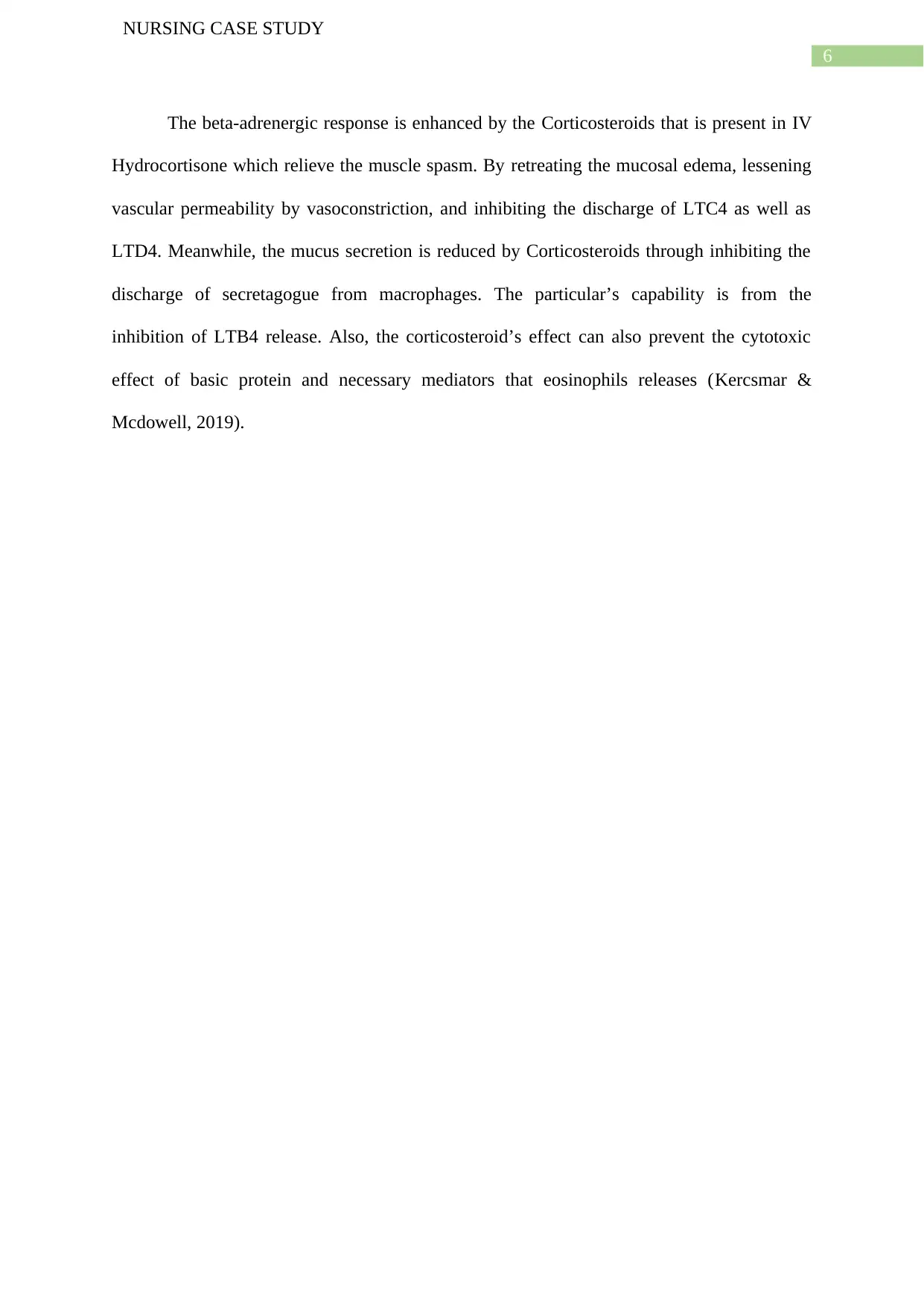
6
NURSING CASE STUDY
The beta-adrenergic response is enhanced by the Corticosteroids that is present in IV
Hydrocortisone which relieve the muscle spasm. By retreating the mucosal edema, lessening
vascular permeability by vasoconstriction, and inhibiting the discharge of LTC4 as well as
LTD4. Meanwhile, the mucus secretion is reduced by Corticosteroids through inhibiting the
discharge of secretagogue from macrophages. The particular’s capability is from the
inhibition of LTB4 release. Also, the corticosteroid’s effect can also prevent the cytotoxic
effect of basic protein and necessary mediators that eosinophils releases (Kercsmar &
Mcdowell, 2019).
NURSING CASE STUDY
The beta-adrenergic response is enhanced by the Corticosteroids that is present in IV
Hydrocortisone which relieve the muscle spasm. By retreating the mucosal edema, lessening
vascular permeability by vasoconstriction, and inhibiting the discharge of LTC4 as well as
LTD4. Meanwhile, the mucus secretion is reduced by Corticosteroids through inhibiting the
discharge of secretagogue from macrophages. The particular’s capability is from the
inhibition of LTB4 release. Also, the corticosteroid’s effect can also prevent the cytotoxic
effect of basic protein and necessary mediators that eosinophils releases (Kercsmar &
Mcdowell, 2019).
Paraphrase This Document
Need a fresh take? Get an instant paraphrase of this document with our AI Paraphraser
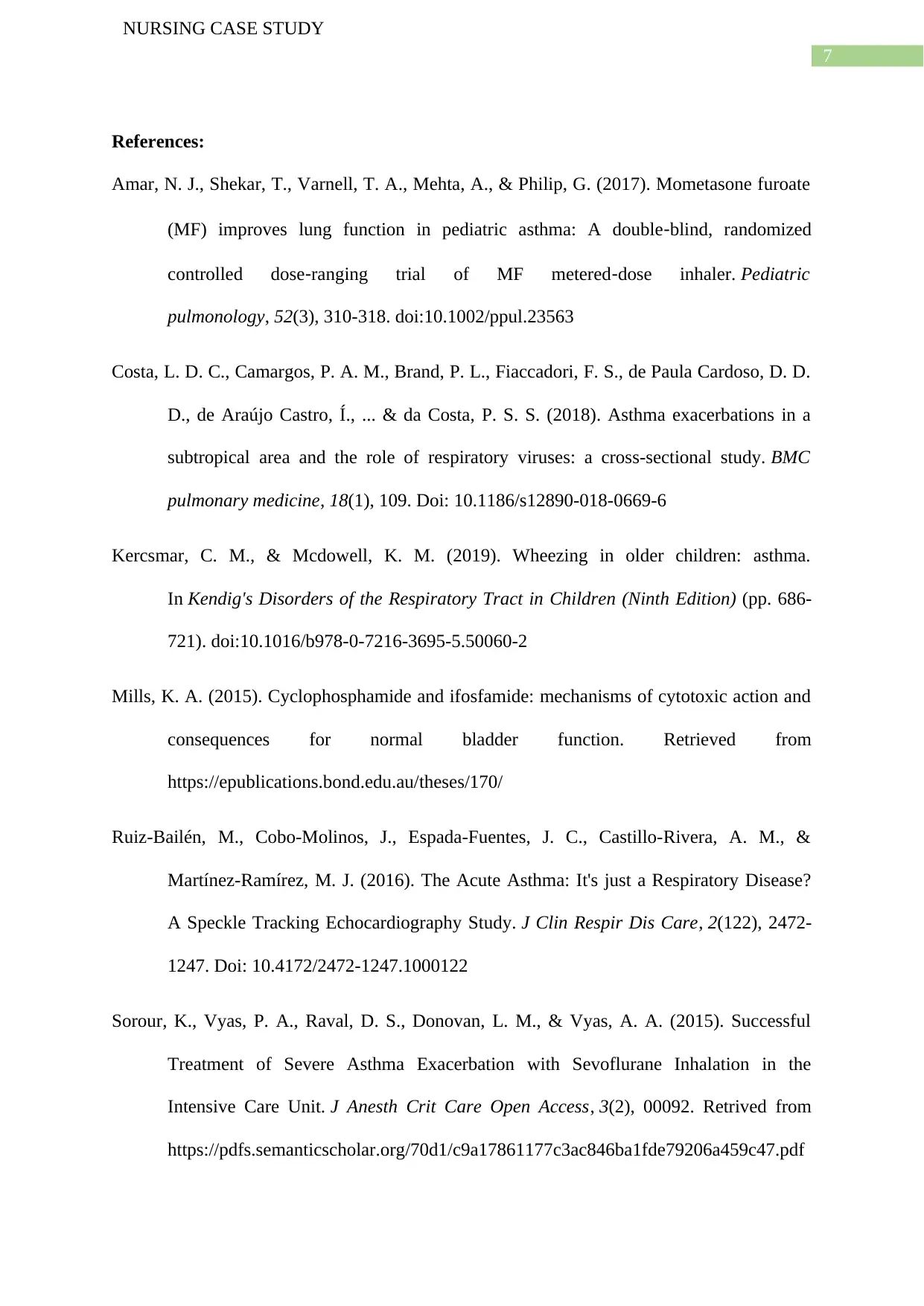
7
NURSING CASE STUDY
References:
Amar, N. J., Shekar, T., Varnell, T. A., Mehta, A., & Philip, G. (2017). Mometasone furoate
(MF) improves lung function in pediatric asthma: A double‐blind, randomized
controlled dose‐ranging trial of MF metered‐dose inhaler. Pediatric
pulmonology, 52(3), 310-318. doi:10.1002/ppul.23563
Costa, L. D. C., Camargos, P. A. M., Brand, P. L., Fiaccadori, F. S., de Paula Cardoso, D. D.
D., de Araújo Castro, Í., ... & da Costa, P. S. S. (2018). Asthma exacerbations in a
subtropical area and the role of respiratory viruses: a cross-sectional study. BMC
pulmonary medicine, 18(1), 109. Doi: 10.1186/s12890-018-0669-6
Kercsmar, C. M., & Mcdowell, K. M. (2019). Wheezing in older children: asthma.
In Kendig's Disorders of the Respiratory Tract in Children (Ninth Edition) (pp. 686-
721). doi:10.1016/b978-0-7216-3695-5.50060-2
Mills, K. A. (2015). Cyclophosphamide and ifosfamide: mechanisms of cytotoxic action and
consequences for normal bladder function. Retrieved from
https://epublications.bond.edu.au/theses/170/
Ruiz-Bailén, M., Cobo-Molinos, J., Espada-Fuentes, J. C., Castillo-Rivera, A. M., &
Martínez-Ramírez, M. J. (2016). The Acute Asthma: It's just a Respiratory Disease?
A Speckle Tracking Echocardiography Study. J Clin Respir Dis Care, 2(122), 2472-
1247. Doi: 10.4172/2472-1247.1000122
Sorour, K., Vyas, P. A., Raval, D. S., Donovan, L. M., & Vyas, A. A. (2015). Successful
Treatment of Severe Asthma Exacerbation with Sevoflurane Inhalation in the
Intensive Care Unit. J Anesth Crit Care Open Access, 3(2), 00092. Retrived from
https://pdfs.semanticscholar.org/70d1/c9a17861177c3ac846ba1fde79206a459c47.pdf
NURSING CASE STUDY
References:
Amar, N. J., Shekar, T., Varnell, T. A., Mehta, A., & Philip, G. (2017). Mometasone furoate
(MF) improves lung function in pediatric asthma: A double‐blind, randomized
controlled dose‐ranging trial of MF metered‐dose inhaler. Pediatric
pulmonology, 52(3), 310-318. doi:10.1002/ppul.23563
Costa, L. D. C., Camargos, P. A. M., Brand, P. L., Fiaccadori, F. S., de Paula Cardoso, D. D.
D., de Araújo Castro, Í., ... & da Costa, P. S. S. (2018). Asthma exacerbations in a
subtropical area and the role of respiratory viruses: a cross-sectional study. BMC
pulmonary medicine, 18(1), 109. Doi: 10.1186/s12890-018-0669-6
Kercsmar, C. M., & Mcdowell, K. M. (2019). Wheezing in older children: asthma.
In Kendig's Disorders of the Respiratory Tract in Children (Ninth Edition) (pp. 686-
721). doi:10.1016/b978-0-7216-3695-5.50060-2
Mills, K. A. (2015). Cyclophosphamide and ifosfamide: mechanisms of cytotoxic action and
consequences for normal bladder function. Retrieved from
https://epublications.bond.edu.au/theses/170/
Ruiz-Bailén, M., Cobo-Molinos, J., Espada-Fuentes, J. C., Castillo-Rivera, A. M., &
Martínez-Ramírez, M. J. (2016). The Acute Asthma: It's just a Respiratory Disease?
A Speckle Tracking Echocardiography Study. J Clin Respir Dis Care, 2(122), 2472-
1247. Doi: 10.4172/2472-1247.1000122
Sorour, K., Vyas, P. A., Raval, D. S., Donovan, L. M., & Vyas, A. A. (2015). Successful
Treatment of Severe Asthma Exacerbation with Sevoflurane Inhalation in the
Intensive Care Unit. J Anesth Crit Care Open Access, 3(2), 00092. Retrived from
https://pdfs.semanticscholar.org/70d1/c9a17861177c3ac846ba1fde79206a459c47.pdf
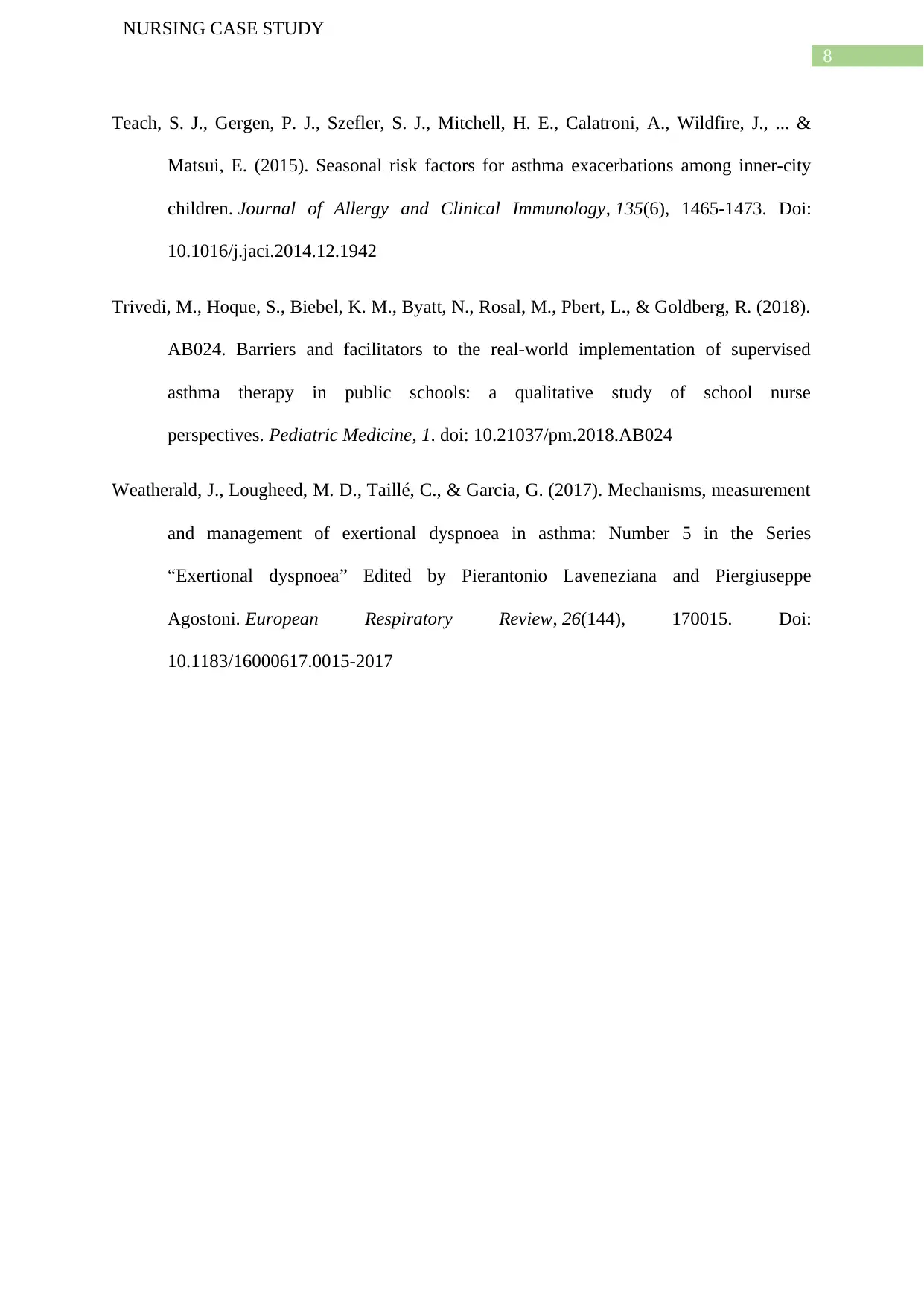
8
NURSING CASE STUDY
Teach, S. J., Gergen, P. J., Szefler, S. J., Mitchell, H. E., Calatroni, A., Wildfire, J., ... &
Matsui, E. (2015). Seasonal risk factors for asthma exacerbations among inner-city
children. Journal of Allergy and Clinical Immunology, 135(6), 1465-1473. Doi:
10.1016/j.jaci.2014.12.1942
Trivedi, M., Hoque, S., Biebel, K. M., Byatt, N., Rosal, M., Pbert, L., & Goldberg, R. (2018).
AB024. Barriers and facilitators to the real-world implementation of supervised
asthma therapy in public schools: a qualitative study of school nurse
perspectives. Pediatric Medicine, 1. doi: 10.21037/pm.2018.AB024
Weatherald, J., Lougheed, M. D., Taillé, C., & Garcia, G. (2017). Mechanisms, measurement
and management of exertional dyspnoea in asthma: Number 5 in the Series
“Exertional dyspnoea” Edited by Pierantonio Laveneziana and Piergiuseppe
Agostoni. European Respiratory Review, 26(144), 170015. Doi:
10.1183/16000617.0015-2017
NURSING CASE STUDY
Teach, S. J., Gergen, P. J., Szefler, S. J., Mitchell, H. E., Calatroni, A., Wildfire, J., ... &
Matsui, E. (2015). Seasonal risk factors for asthma exacerbations among inner-city
children. Journal of Allergy and Clinical Immunology, 135(6), 1465-1473. Doi:
10.1016/j.jaci.2014.12.1942
Trivedi, M., Hoque, S., Biebel, K. M., Byatt, N., Rosal, M., Pbert, L., & Goldberg, R. (2018).
AB024. Barriers and facilitators to the real-world implementation of supervised
asthma therapy in public schools: a qualitative study of school nurse
perspectives. Pediatric Medicine, 1. doi: 10.21037/pm.2018.AB024
Weatherald, J., Lougheed, M. D., Taillé, C., & Garcia, G. (2017). Mechanisms, measurement
and management of exertional dyspnoea in asthma: Number 5 in the Series
“Exertional dyspnoea” Edited by Pierantonio Laveneziana and Piergiuseppe
Agostoni. European Respiratory Review, 26(144), 170015. Doi:
10.1183/16000617.0015-2017
1 out of 9
Related Documents
Your All-in-One AI-Powered Toolkit for Academic Success.
+13062052269
info@desklib.com
Available 24*7 on WhatsApp / Email
![[object Object]](/_next/static/media/star-bottom.7253800d.svg)
Unlock your academic potential
© 2024 | Zucol Services PVT LTD | All rights reserved.



